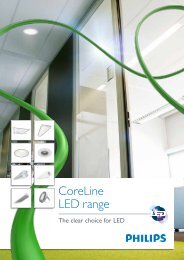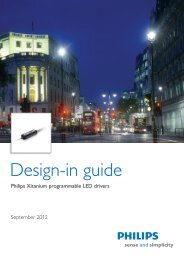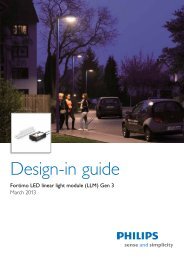Design-in Guide for Xtreme drivers low wattage - Philips Lighting
Design-in Guide for Xtreme drivers low wattage - Philips Lighting
Design-in Guide for Xtreme drivers low wattage - Philips Lighting
Create successful ePaper yourself
Turn your PDF publications into a flip-book with our unique Google optimized e-Paper software.
5 Class I and Class II applications<br />
(s)<strong>Xtreme</strong> gears are compliant with Class I and Class II applications.<br />
Look<strong>in</strong>g from the ma<strong>in</strong>s side, the differences between Class I and Class II are as fol<strong>low</strong>s: In a Class I application<br />
the ma<strong>in</strong>s always has a safety earth conductor. All metal parts that can become live <strong>in</strong> a fault condition are<br />
connected to safety earth. Class II equipment has no protective earth term<strong>in</strong>al (PE). In Class II applications safety<br />
is guaranteed by double or re<strong>in</strong><strong>for</strong>ced <strong>in</strong>sulation of active conductors.<br />
Class I<br />
In Class I applications all touchable metal parts have to be connected to safety earth. This prevents the parts from<br />
becom<strong>in</strong>g live <strong>in</strong> the event of a failure. First of all the voltage is limited to a <strong>low</strong>, safe level. After a short time, the<br />
fuse protect<strong>in</strong>g the ma<strong>in</strong>s will b<strong>low</strong> or the MCB will trip. Low Wattage Xt gear has a functional earth connector (FE).<br />
This connector is p<strong>in</strong>k <strong>in</strong> colour to dist<strong>in</strong>guish it from a PE connector, which is often green or green/yel<strong>low</strong>. The<br />
functional earth term<strong>in</strong>al has to be connected to the metal structure <strong>for</strong> EMC and surge voltage protection reasons.<br />
By do<strong>in</strong>g so, the functional earth of the gear is connected to safety earth. But the connector on the gear still has<br />
only a functional purpose and is not safety-related.<br />
Class II<br />
In Class II applications no safety earth is present, so a s<strong>in</strong>gle fault can never cause touchable metal parts to<br />
become live. The circuitry <strong>in</strong>side the gear provides an <strong>in</strong>sulation value that meets Class II specifications.<br />
Connect<strong>in</strong>g the functional earth term<strong>in</strong>al to the metal structure <strong>for</strong> EMC and surge voltage protection reasons will<br />
not violate Class II regulations. The earth term<strong>in</strong>al of the gear has only a functional earth purpose and must be<br />
connected to a large metal part to withstand lightn<strong>in</strong>g strikes. The Low Wattage Xt-gear‟s hous<strong>in</strong>g meets Class II<br />
specifications, except <strong>for</strong> the mechanical/electrical connection of wires. The OEM is responsible <strong>for</strong> the strip length<br />
and connection of wires.<br />
5.1 Compliance to Class I/ Class II with maximum per<strong>for</strong>mance on EMC<br />
By fol<strong>low</strong><strong>in</strong>g the advice be<strong>low</strong>, the (s)Xt gear will comply to Class I or II regulations and will have maximum<br />
per<strong>for</strong>mance on EMC and also surge voltage protection (Xt gear). The robustness of the Xt gear can only be<br />
guaranteed if the fol<strong>low</strong><strong>in</strong>g measures are taken:<br />
The distance from bare ma<strong>in</strong>s conductor parts to any metal part should be at least 8mm and preferably<br />
10mm.<br />
The distance from bare lamp circuit parts to any metal part should be at least 8mm and preferably 10mm.<br />
All wir<strong>in</strong>g should be of the double or re<strong>in</strong><strong>for</strong>ced <strong>in</strong>sulation type.<br />
All metal parts <strong>in</strong> the fixture should be connected to the gear‟s functional earth term<strong>in</strong>al, regardless of<br />
whether the application is Class I or Class II.<br />
Putt<strong>in</strong>g a sleeve around the lamp wires can provide extra <strong>in</strong>sulation <strong>in</strong> the event of surge voltages and<br />
keeps the conductors together <strong>for</strong> EMC at the same time.<br />
The dotted l<strong>in</strong>e (see Figure 8) shows the difference between Class I and Class II.<br />
17

















